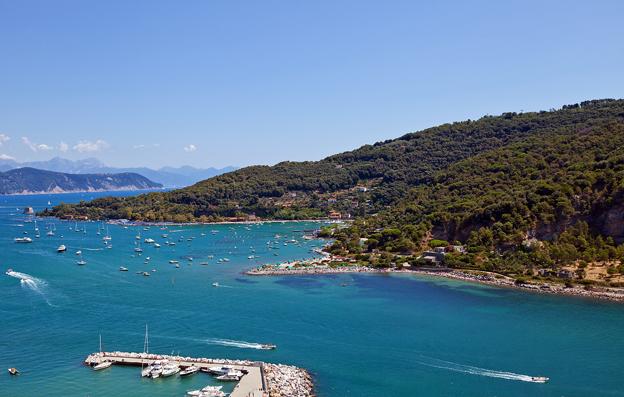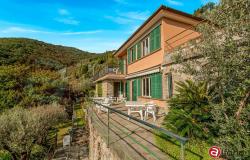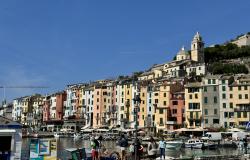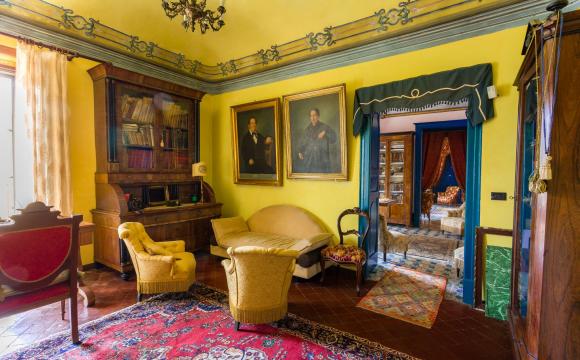Continuing with our series on the Italian islands, this week we shall be featuring the five islands that languish in the Ligurian sea, the body of water sandwiched between the Mediterranean and Tyrrhenian seas, stretching from the Italian Riviera to Tuscany and resting upon the shores of Corsica.
There are five islands in the Ligurian Sea and all are now protected nature reserves or part of the collection of Italian national parks, the one thing they all have in common is their beauty and preserved flora.
Palmaria

The largest of the islands is Palmaria, which also makes up part of the Archipelago of Portovenere. The island’s name originally derives from the dialect balme, meaning cave, and some people do still pronounce the name as Balmaria rather than Palmaria.
Although this island situated at the western end of the Gulf of La Spezia is the largest, it only measures a mere 1.6 square kilometres (0.6 miles²) and along with its closest neighbours, Tino and Tinetto a few metres south, it was designated a UNESCO World Heritage Site in 1997.
The island has a handful of houses and even a restaurant, but no real large-scale human habitation, but the trails and paths that cross the island are of remarkable naturalistic beauty, not to mention the fragrances of myrtle, acacia and the strawberry tree, making it an ideal destination for walkers.
There are a number of caves, some are accessible, while others, like the Grotta dei Colombi (Cave of Pigeons) can only be accessed by climbing down ropes; La Grotta Azzurra (The Blue Cave) can only be visited by boat. The caves have proven to be of great historical importance after the fossilised bones of animals including chamois and the remains of human burials dating back to the Pleistocene period were discovered, proving the island was at some point populated at least 5,000 years ago by humans.
Divers are attracted by the underwater caves and marine life around the island, with the sea floor dropping to a considerable depth nearby, where in the 1960s the free diver Enzo Majorca attempted one of his records.
It takes around three hours to walk around Palmaria and, at the top of the island, sits a 19th century Savoy-built military fortification which has now been refurbished and houses a marine and environmental education centre. If you do choose to walk across the island, save time to traverse the Sentiero dei Condannati (Trail of the Condemned), a steep staircase through lush vegetation that leads the walker down to the edge of the Portovenere archipelago. (Not suitable for people with mobility issues.)
Tinetto

With a circumference of just 300 metres and a height of just 18 metres, the island of Tinetto is little more than a large rock jutting out above the waves, but its rugged beauty is what makes it worthy of a photographic opportunity. The island is mostly devoid of vegetation with the exception of a small area of scrubby growth on the uppermost part.
There are the remains of several early medieval monastic cells that date back to the 6th and 7th centuries, and on the western point is the ruin of a small 6th century chapel, but otherwise there’s very little to entertain the curious visitor. However, like Palmaria, the waters around Tinetto attract divers, especially the Fossa del Tinetto, a vertical shaft that creates a surprising play of light in this underwater environment.
Visitors to Tinetto may also be lucky enough to catch a glimpse of podarcis muralis tinettoi, an extremely rare and endangered sub-species of wall lizard, now found only upon this island.
Tino

With a 2 kilometre circumference containing an area of 127,000 m², Isola del Tino is part of a military zone and has previously been inaccessible, except on September 13 when it is opened to the public on the occasion of the Feast of San Venerio. However, thanks to a joint venture between the Navy and the Portovenere Park, the island now has a monthly guided hike.
Venerius the hermit, who went on to become Saint Venerio and patron of the Gulf of La Spezia, lived on the island for many years until his death in 630. Legend tells us that St. Venerio would light bonfires on the island’s summit to warn ships of its location and because of this, in 1961, he was also made the patron saint of Italian lighthouse keepers.
A 9th century Benedictine monastery was built over the Saint’s tomb to protect his relics but because of repeated attacks by Moors and Vikings, the tomb contents were temporarily transferred to Reggio Emilia to reside beside those of Saint Prosper of Reggio (San Prospero). They have now since been returned to Tino.
The island has a diverse mix of vegetation including sea fennel, red valerian and the horned poppy. Among this fragrant blanket of green lives Euleptes, Europe’s smallest reptile, a monotypic genus of gecko.
The western part of the island is inaccessible due to the high, almost vertical cliffs, but there is a small marina in the north-east; as this is still under control of the Navy, the mooring of non-authorised boats is prohibited.
Gallinara

Located a kilometre from the coast, facing Capo Santa Croce in the town of Albenga, is the oddly hump-shaped island of Gallinara and its nature reserve.
Once populated by wild fowl, hence its name, at the end of the 4th century, it became a temporary refuge of Saint Martin of Tours; a monastic community grew and the first order of Saint Columbanus was formed to honour the Irish missionary who had himself been a founder of many religious ministries.
The southern and eastern sides of the island are made up of sheer cliffs which house various sea birds like cormorants, petrel and the largest European population of yellow-legged gulls. The waters around the cliffs have seen many shipwrecks over the years with artefacts dating back to the 5th century being recovered from beneath them.
It is another popular destination with divers, who perhaps come to scour the sea bed for ancient relics from the wrecked ships. Punta Falconara is popular with divers due to the giant statue of Christ beneath the blue waters; with depths of up to 30 metres, Punta Sciusciau gives divers the opportunity to get up close to octopus, scorpion fish and if they’re brave enough, moray eels.
If you want to take a break from diving, Isola di Gallinara is an ideal island for walkers, with over 10 kilometres of paths criss-crossing its terrain.
Bergeggi

Isola di Bergeggi is a 53-metre-high cornet-shaped limestone rock in the province of Savona, just 250 metres from the shore of the town that shares its name.
It is another popular port of call with divers; Canalone is great for beginners with a depth of 7-10 metres, Pifferaio dives to around 18 metres and Franata to around 30 metres. Many who come here marvel at the proliferation of algae and sponges in the area, in fact the seas around Bergeggi are the perfect habitat for anyone wanting to see sea perch, lobsters and the monstrous-looking angler fish. The pink coral coloured coralline seaweed grows in abundance as does the sea grass, posidonia oceanica, creating great underwater meadows.
The vast array of vegetation isn’t confined to just the sea bed as the island is prolifically covered, making it ideal for your inner botanist. Interesting plant species can be found here, like euphorbia arborea and campanula sabatia, a rare Italian bell-shaped flowering plant that has since been classified as vulnerable on the ICUN Red List of Threatened Species. Due to the diversity of flora, the island, which is part of the Regional Nature Reserve, is protected under a national preservation program.
Across from the island is the small town with the same name, situated high up and overlooking both the island and the sea which, with its clarity of water and its sandy beaches, is popular with tourists.
The island has a sheltered anchorage for those arriving by boat for a relaxing day among the beauty that nature provides.









